
This video defines compound words and provides examples.
- Subject:
- English Language Arts
- Material Type:
- Lecture
- Provider:
- Institute of Education Sciences
- Date Added:
- 10/31/2023

This video defines compound words and provides examples.
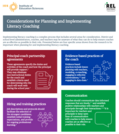
Implementing literacy coaching is a complex process that includes several areas for consideration. District and school-level administrators, coaches, and teachers may be unaware of what they can do to help ensure coaches are as effective as possible in their role. Presented in this infographic are four specific areas shown from the research to be important when planning for and implementing literacy coaching.

"Children entering kindergarten vary greatly in their language and literacy skills. Therefore, up-to-date information about evidence-based practices is essential for early childhood educators and policymakers as they support preschool children’s language and literacy development...More than 74,000 studies were analyzed to identify interventions that improved students’ performance in six language and literacy domains (language, phonological awareness, print knowledge, decoding, early writing, and general literacy). The findings revealed that instruction that teaches a specific domain is likely to increase performance in that domain. Interventions that teach language exclusively might be more beneficial when conducted in small groups or one-on-one than in larger group sizes. In addition, teaching both phonological awareness and print knowledge might benefit performance in print knowledge. Finally, some evidence indicates that instruction that teaches both phonological awareness and print knowledge might also lead to improvements in decoding and early writing performance" (IES, 2021).

Familias y cuidadores: ustedes tienen un papel importante en el aprendizaje del lenguaje de sus hijos. Los niños pueden aprender palabras nuevas todos los días escuchando, hablando, escribiendo y dibujando. El propósito de esta actividad es ayudar a los niños a aprender y practicar un conjunto pequeño de palabras nuevas durante un tiempo, adaptándolas a su vocabulario.

Familias y cuidadores: ustedes tienen un papel importante en el aprendizaje del lenguaje de sus niños. Los niños pueden aprender palabras nuevas todos los días y desarrollar su vocabulario utilizando lenguaje descriptivo. Al jugar este juego, usted y su niño o niña utilizarán el lenguaje para describir y adivinar objetos del hogar escondidos.

Familias y cuidadores: ustedes tienen un papel importante en el aprendizaje del lenguaje de sus niños. Los niños pueden fortalecer su lenguaje todos los días, haciendo y respondiendo preguntas sobre una experiencia. En esta actividad, usted le pedirá a su niño o niña que hable sobre una experiencia que haya tenido.

Familias y cuidadores: ustedes tienen un papel importante en el aprendizaje del lenguaje de sus niños. Los niños pueden fortalecer su lenguaje todos los días, haciendo y respondiendo preguntas sobre una historia. En esta actividad, usted le pedirá a su niño o niña que hable sobre lo que lee, escucha o sabe sobre una historia.

Familias y cuidadores: ustedes tienen un papel importante en el aprendizaje del lenguaje de sus niños. Los niños pueden fortalecer su lenguaje todos los días, haciendo y respondiendo preguntas sobre un tema o un texto informativo. En esta actividad, usted le pedirá a su niño o niña que hable sobre lo que lee, escucha o sabe sobre un tema o un texto informativo.

Familias y cuidadores: ustedes tienen un papel importante en el aprendizaje del lenguaje de sus niños. Los niños pueden aprender palabras nuevas todos los días escuchando, hablando, escribiendo y dibujando. El propósito de esta actividad es ayudar a los niños a utilizar textos informativos, haciendo que aprendan y practiquen usando un pequeño conjunto de palabras nuevas del texto. Usted apoyará a su niño o niña mientras lee, habla, dibuja, juega o escribe las nuevas palabras.

Familias y cuidadores: ustedes tienen un papel importante en el aprendizaje del lenguaje de sus niños. Los niños pueden desarrollar su vocabulario aprendiendo y practicando nuevas palabras durante las tareas cotidianas, por ejemplo, al preparar una comida. En esta actividad, usted preparará una comida con su niño o niña, enfocándose en el proceso y las palabras nuevas y ayudándolos a escribir la receta.
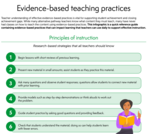
Teacher understanding of effective evidence-based practices is vital for supporting student achievement and closing achievement gaps. While many alternative pathway teachers know what content they must teach, many have never had classes on how to teach the content using evidence-based practices. This infographic is a quick reference guide containing evidence-based practices that can impact learning that teachers can use daily to support effective instruction.

Family Literacy Videos targeted for families with first grade students. The videos show families engaging their child in evidence-based literacy activities. The video playlist and corresponding document outlining the topics align with IES Practice Guides "A Kindergarten Teacher's Guide to Supporting Family Involvement in Foundational Reading Skills" and "Foundational Skills to Support Reading for Understanding in Kindergarten through Third Grade."
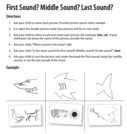
This resource from the Institute for Education Sciences helps teachers and parents build children's phonemic awareness by having children identifying the sound and its' position within the word that is the same in two pictures (ex: dog and duck have the same sound in the initial position of the word). This resources provides directions on how to engage in this phonemic awareness activity with children.

This video features an extended interview with Tim Shanahan, Ph.D., and includes descriptions of research-based recommendations from the What Works Clearinghouse about how to teach literacy to young students.

This video shows how to implement research-based literacy practices from the What Works Clearinghouse through play-based learning.

Family Literacy Videos targeted for families with Kindergarten students. The videos show families engaging their child in evidence-based literacy activities. The video playlist and corresponding document outlining the topics align with IES Practice Guides "A Kindergarten Teacher's Guide to Supporting Family Involvement in Foundational Reading Skills" and "Foundational Skills to Support Reading for Understanding in Kindergarten through Third Grade."

This video defines connectives and provides examples.

This resource from the Institute for Education Sciences helps teachers and parents build children's phonological awareness. In this activity, students will take apart and put together onsets and rimes by matching picture puzzle pieces.
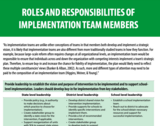
This resource explains the different roles and responsibilities of implementation team leaders as well as how they evolve through phases of intervention and implementation.
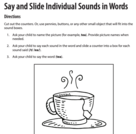
This resource will help teachers and parents to build children's phonemic awareness. In this activity, the child will name the picture, say and slide counters for each sound, and say the word.